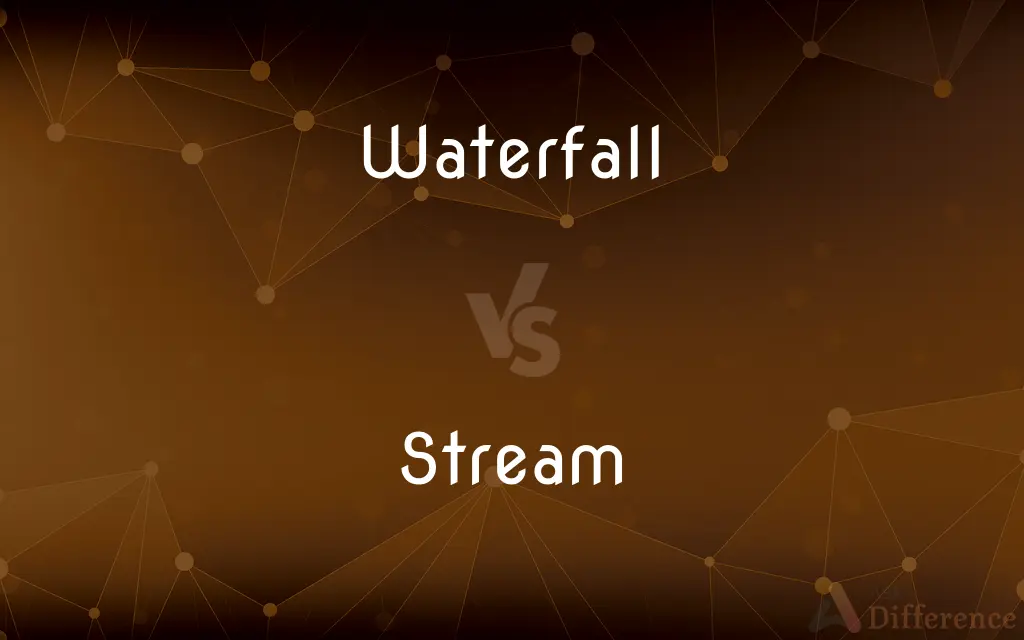Waterfall vs. Stream — What's the Difference?
By Tayyaba Rehman & Fiza Rafique — Updated on March 7, 2024
Waterfalls are vertical flows of water that drop over a cliff, showcasing nature's power and beauty, while streams are gently flowing bodies of water that move across the land, highlighting tranquility and continuity.

Difference Between Waterfall and Stream
Table of Contents
ADVERTISEMENT
Key Differences
Waterfalls, characterized by their dramatic plunge from heights, create stunning natural landscapes. They often form in areas where water flows over a vertical drop or a series of steep drops in the course of a stream or river. On the other hand, streams offer a more serene setting, flowing continuously over varied terrain, and are crucial for the ecosystems they traverse, providing habitats and resources for a wide range of organisms.
The creation of waterfalls is typically the result of geological processes, such as erosion, where harder rock layers resist erosion better than the underlying softer layers, leading to the formation of a cliff or a precipice. Streams, however, develop from the accumulation of runoff water, seeping through the ground or flowing over it, and their paths are shaped by the topography of the land, gradually altering landscapes through erosion and sediment deposition.
Waterfalls are often seen as natural wonders, drawing tourists for their aesthetic and recreational values. They serve as focal points in national parks and natural reserves around the world. Streams, while less dramatic, play a vital role in hydrological cycles, supporting agriculture, drinking water supplies, and recreational activities like fishing and canoeing.
The ecological impact of waterfalls extends beyond their visual appeal; they act as barriers for aquatic organisms, creating diverse habitats above and below the falls. Streams, in contrast, connect ecosystems, facilitating the movement of species and nutrients across landscapes, and contributing to the biodiversity of the areas they flow through.
Both waterfalls and streams are affected by environmental changes. Waterfalls may see alterations in their flow patterns or volume due to upstream water usage or climate change. Similarly, streams are susceptible to pollution, overuse, and alterations in their course, which can significantly impact their ecological function and health.
ADVERTISEMENT
Comparison Chart
Definition
A vertical flow of water over a cliff
A gently flowing body of water across land
Formation
Erosion, vertical drops in terrain
Accumulation of runoff, shaped by land topography
Ecological Role
Creates diverse habitats, barrier for some species
Connects ecosystems, supports biodiversity
Aesthetic Value
Dramatic landscapes, tourist attraction
Tranquil settings, less dramatic but scenic
Human Interaction
Tourism, recreation
Agriculture, drinking water, recreation
Environmental Impact
Affected by upstream water use, climate change
Susceptible to pollution, overuse, course alteration
Geological Process
Erosion of rock layers
Erosion and sediment deposition
Compare with Definitions
Waterfall
Often results from erosion and geological changes.
The waterfall carved its way through the landscape over millennia.
Stream
A small to medium body of flowing water.
A clear stream runs through the forest, teeming with fish.
Waterfall
Can be seasonal or perennial, depending on water flow.
The waterfall only appears in spring when the snow melts.
Stream
Crucial for connecting ecosystems and supporting wildlife.
The stream is a vital water source for the area's wildlife.
Waterfall
Serves as a significant natural attraction.
Tourists flock to see the majestic waterfalls in the national park.
Stream
Supports human activities like agriculture and recreation.
Locals use the stream for irrigation and kayaking.
Waterfall
A natural formation where water falls from a height.
Niagara Falls is a breathtaking waterfall on the border of the United States and Canada.
Stream
Shapes the landscape through erosion and sediment transport.
Over centuries, the stream has carved a deep valley.
Waterfall
Influences local ecosystems by creating unique habitats.
The waterfall's mist zone supports a variety of mosses and ferns.
Stream
Can be influenced by seasonal changes in water volume.
The stream swells with water during the rainy season.
Waterfall
A cascade of water falling from a height, formed when a river or stream flows over a precipice or steep incline.
Stream
A small, narrow river
A perfect trout stream
Waterfall
A waterfall is an area where water flows over a vertical drop or a series of steep drops in the course of a stream or river. Waterfalls also occur where meltwater drops over the edge of a tabular iceberg or ice shelf.
Stream
A stream is a body of water with surface water flowing within the bed and banks of a channel. The flow of a stream is controlled by three inputs – surface water, subsurface water and groundwater.
Waterfall
Relating to or denoting a method of project management that is characterized by sequential stages and a fixed plan of work
Each phase of a waterfall project must be complete prior to moving to the next phase
Stream
A continuous flow of data or instructions, typically one having a constant or predictable rate.
Waterfall
A steep descent of water from a height; a cascade.
Stream
A group in which schoolchildren of the same age and ability are taught.
Children in the top streams
Waterfall
A flow of water over the edge of a cliff.
Stream
(of liquid, air, gas, etc.) run or flow in a continuous current in a specified direction
She sat with tears streaming down her face
Sunlight streamed through the windows
Waterfall
(figuratively) A waterfall-like outpouring of liquid, smoke, etc.
A waterfall of mist came from the open freezer.
Stream
Transmit or receive (data, especially video and audio material) over the Internet as a steady, continuous flow.
Waterfall
Waterfall model
A very long duration project ... had taken a whole group of people through a painful waterfall development process.
Stream
Put (schoolchildren) in groups of the same age and ability to be taught together.
In the coming school year, we were to be streamed
Waterfall
The action of drinking from a vessel without touching it with the lips, considered more sanitary for a shared vessel.
Hey man, can I take a waterfall from your bottle?
Stream
A flow of water in a channel or bed, as a brook, rivulet, or small river.
Waterfall
A necktie.
Stream
A steady current in such a flow of water.
Waterfall
A chignon.
Stream
A steady current of a fluid.
Waterfall
A beard.
Stream
A large amount or number moving or occurring in steady succession
A stream of commuters.
A stream of insults.
Waterfall
(intransitive) To fall like a waterfall.
Stream
A trend, course, or drift, as of opinion, thought, or history.
Waterfall
(transitive) To drink (something) from a container by pouring it from a height so as not to touch one's lips to the rim.
Stream
A beam or ray of light.
Waterfall
(roller derby) recycle
Stream
Chiefly British A course of study to which students are tracked.
Waterfall
A fall, or perpendicular descent, of the water of a river or stream, or a descent nearly perpendicular; a cascade; a cataract.
Stream
(Computers) A steady flow of data.
Waterfall
An arrangement of a woman's back hair over a cushion or frame in some resemblance to a waterfall.
Stream
To flow in a stream or current.
Waterfall
A certain kind of neck scarf.
Stream
To pour forth or give off a stream; flow
My eyes were streaming with tears.
Waterfall
A steep descent of the water of a river
Stream
To move or arrive in large numbers; pour
Traffic was streaming by. Fan mail streamed in.
Stream
To extend, wave, or float outward
The banner streamed in the breeze.
Stream
To leave a continuous trail of light.
Stream
To give forth a continuous stream of light rays or beams; shine.
Stream
To emit, discharge, or exude (a body fluid, for example).
Stream
(Computers) To transmit or receive (audio or video content), especially over the internet, in small, sequential packets that permit the content to be played continuously as it is being received and without saving it to a hard disk.
Stream
A small river; a large creek; a body of moving water confined by banks.
Stream
A thin connected passing of a liquid through a lighter gas (e.g. air).
He poured the milk in a thin stream from the jug to the glass.
Stream
Any steady flow or succession of material, such as water, air, radio signal or words.
Her constant nagging was to him a stream of abuse.
Stream
All moving waters.
Stream
(computing) A source or repository of data that can be read or written only sequentially.
Stream
(figurative) A particular path, channel, division, or way of proceeding.
Haredi Judaism is a stream of Orthodox Judaism characterized by rejection of modern secular culture.
Stream
A division of a school year by perceived ability.
All of the bright kids went into the A stream, but I was in the B stream.
Stream
A live stream.
Stream
(intransitive) To flow in a continuous or steady manner, like a liquid.
Stream
(intransitive) To extend; to stretch out with a wavy motion; to float in the wind.
A flag streams in the wind.
Stream
(Internet) To push continuous data (e.g. music) from a server to a client computer while it is being used (played) on the client.
Stream
A current of water or other fluid; a liquid flowing continuously in a line or course, either on the earth, as a river, brook, etc., or from a vessel, reservoir, or fountain; specifically, any course of running water; as, many streams are blended in the Mississippi; gas and steam came from the earth in streams; a stream of molten lead from a furnace; a stream of lava from a volcano.
Stream
A beam or ray of light.
Stream
Anything issuing or moving with continued succession of parts; as, a stream of words; a stream of sand.
Stream
A continued current or course; as, a stream of weather.
Stream
Current; drift; tendency; series of tending or moving causes; as, the stream of opinions or manners.
Stream
To issue or flow in a stream; to flow freely or in a current, as a fluid or whatever is likened to fluids; as, tears streamed from her eyes.
Beneath those banks where rivers stream.
Stream
To pour out, or emit, a stream or streams.
A thousand suns will stream on thee.
Stream
To issue in a stream of light; to radiate.
Stream
To extend; to stretch out with a wavy motion; to float in the wind; as, a flag streams in the wind.
Stream
To send forth in a current or stream; to cause to flow; to pour; as, his eyes streamed tears.
It may so please that she at length will streamSome dew of grace into my withered heart.
Stream
To mark with colors or embroidery in long tracts.
The herald's mantle is streamed with gold.
Stream
To unfurl.
Stream
A natural body of running water flowing on or under the earth
Stream
Dominant course (suggestive of running water) of successive events or ideas;
Two streams of development run through American history
Stream of consciousness
The flow of thought
The current of history
Stream
A steady flow (usually from natural causes);
The raft floated downstream on the current
He felt a stream of air
Stream
The act of flowing or streaming; continuous progression
Stream
Something that resembles a flowing stream in moving continuously;
A stream of people emptied from the terminal
The museum had planned carefully for the flow of visitors
Stream
To extend, wave or float outward, as if in the wind;
Their manes streamed like stiff black pennants in the wind
Stream
Move in large numbers;
People were pouring out of the theater
Beggars pullulated in the plaza
Stream
Rain heavily;
Put on your rain coat-- it's pouring outside!
Stream
Flow freely and abundantly;
Tears streamed down her face
Common Curiosities
Can waterfalls disappear?
Yes, waterfalls can disappear or significantly reduce in volume due to changes in water flow upstream, geological shifts, or extensive drought conditions.
What role do streams play in ecosystems?
Streams play a crucial role in connecting habitats, supporting diverse life forms, and shaping the landscape through erosion and sediment deposition.
What defines a waterfall?
A waterfall is defined by its vertical drop of water from a height, often over a cliff, forming a visually striking natural feature.
How do streams form?
Streams form from the accumulation of surface water runoff and groundwater seeping out to the surface, flowing continuously over land.
Why are waterfalls significant in nature?
Waterfalls are significant for their aesthetic value, recreational opportunities, and the unique habitats they create for biodiversity.
What are some conservation efforts for streams?
Conservation efforts include protecting riparian zones, reducing pollution sources, restoring natural flow patterns, and safeguarding aquatic habitats.
Why are streams important for agriculture?
Streams provide a critical water source for irrigation, supporting crop growth and livestock watering.
Are all waterfalls the same size?
No, waterfalls vary greatly in size, from small cascades just a few feet high to towering falls hundreds or even thousands of feet tall.
How are waterfalls and streams related?
Waterfalls often occur along the course of a stream or river when there is a sudden vertical drop in the terrain, making them interconnected parts of a watershed.
Is it safe to drink water directly from a stream?
Drinking water directly from a stream can be risky due to potential contamination; it's advisable to treat or filter water first.
How do human activities impact streams?
Human activities can impact streams through pollution, altering their natural course, overuse for irrigation or industry, and affecting their health and biodiversity.
What determines a stream's path?
A stream's path is determined by the topography of the land it flows across, including gradients, obstacles, and the underlying geology.
How does climate change affect waterfalls?
Climate change can alter precipitation patterns, affecting the flow and volume of waterfalls, potentially reducing their size or drying them up.
Can a waterfall form anywhere along a stream?
A waterfall can form anywhere there is a sufficient vertical drop along a stream's course, often due to geological features or erosional processes.
What recreational activities are popular at waterfalls?
Popular activities include hiking, photography, swimming (where safe), and sightseeing.
Share Your Discovery

Previous Comparison
Azurite vs. Malachite
Next Comparison
Corella vs. GalahAuthor Spotlight
Written by
Tayyaba RehmanTayyaba Rehman is a distinguished writer, currently serving as a primary contributor to askdifference.com. As a researcher in semantics and etymology, Tayyaba's passion for the complexity of languages and their distinctions has found a perfect home on the platform. Tayyaba delves into the intricacies of language, distinguishing between commonly confused words and phrases, thereby providing clarity for readers worldwide.
Co-written by
Fiza RafiqueFiza Rafique is a skilled content writer at AskDifference.com, where she meticulously refines and enhances written pieces. Drawing from her vast editorial expertise, Fiza ensures clarity, accuracy, and precision in every article. Passionate about language, she continually seeks to elevate the quality of content for readers worldwide.














































